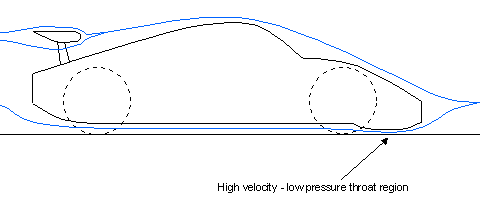|
If we examine the spoiler on the 1996 DTM/ITC Mercedes Benz shown above we notice that it does not have any kind of splitter. In fact, it has the opposite of a splitter. The lower portion of the spoiler curves back in towards the car, instead of jutting out into the stagnation region. The designers were trying to encourage the high pressure air in front of the spoiler to flow underneath the car. This way they could maximize the venturi effect underneath the front of the vehicle. In essence, the front spoiler region of the car forms a "mini ground-effect tunnel". In the "throat" region of the venturi, the air flow speeds up and hence the local pressure goes down. This creates downforce. The longer the throat region is, the more downforce that can be created. A simplified schematic of the air flow over and under a racecar with a spoiler venturi is shown below in Figure 2:
There are many possible permutations of the splitter/venturi spoiler idea. Some racecars use either just a splitter or just a venturi. Other designers have attempted to combine the two devices in an effort to maximize front downforce under modern racing regulations (which usually require a flat under-body from the front axle-line back). Two examples of combined splitter-venturi designs are shown below. These Super Touring cars from the English and German series. Notice in particular that the Volvo S-40 has a splitter going right up and over the venturi inlet.
|



